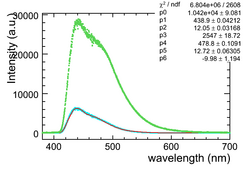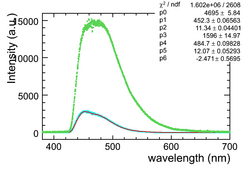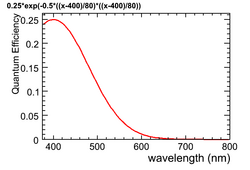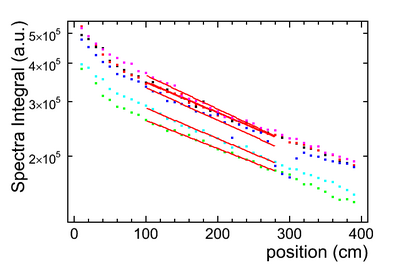Difference between revisions of "Kuraray Fibre Tests"
From GlueXWiki
(→Detector Setup) |
(→Detector Setup) |
||
| Line 6: | Line 6: | ||
#The unpainted end is inserted into and held in place by a [http://www.oceanoptics.com/products/fiberkits.asp#adapter bare-fibre SMA-connector] from Ocean Optics. | #The unpainted end is inserted into and held in place by a [http://www.oceanoptics.com/products/fiberkits.asp#adapter bare-fibre SMA-connector] from Ocean Optics. | ||
#A UV LED (380nm) is used to illuminate the fibre from above, and perpendicularly to the fiber's long axis | #A UV LED (380nm) is used to illuminate the fibre from above, and perpendicularly to the fiber's long axis | ||
| − | #The spectra are obtained using an [http://www.oceanoptics.com/products/usb4000.asp Ocean Optics | + | #The spectra are obtained using an [http://www.oceanoptics.com/products/usb4000.asp Ocean Optics spectrophotometer] |
== Fibre Spectra == | == Fibre Spectra == | ||
Revision as of 23:17, 18 March 2009
Contents
[hide]Detector Setup
- The fibre is cut and polished on both ends with the Fiber Fin polisher (the label must be removed due to it's placement too close to the end)
- The far end of the fibre is painted black with an enamel paint (used for painting scale models).
- The fibre is placed in a 4m x 1mm groove in a black poly-ethylene bar ("puck plastic")
- The unpainted end is inserted into and held in place by a bare-fibre SMA-connector from Ocean Optics.
- A UV LED (380nm) is used to illuminate the fibre from above, and perpendicularly to the fiber's long axis
- The spectra are obtained using an Ocean Optics spectrophotometer
Fibre Spectra
Typical fibre spectra at 10,100 and 300 cm.The green data points are the raw spectra as seen by the photo-spectrometer. The light blue points are scaled by an approximation to the quantum efficiency of a Bi-Alkali photocathode.
Bi-Alkali Quantum efficiency approximation

Attenuation lengths
- The attenuation length is found by taking the integral of the fit function of the scaled spectra and fitting that as a function of distance from the spectrometer. The fit function is a single exponential: I = A * exp(-x/B). The attenuation length is then effectively that of the fibre as seen by a PMT.
So far 6 fibers have had their attenuation lengths measured:
Attenuation length:
| fibre # |  |

|
|---|---|---|
| 01-3 | 440 | 12 |
| 23-2 | 443 | 10 |
| 26-2 | 478 | 10 |
| 32-2 | 414 | 30 |
| 33-2 | 398 | 15 |
| 49-3 | 441 | 12 |
| Avg | 436 | 15 |
The Specifications for the Scintillating Fibres required that "The bulk attenuation length of a bare fiber shall exceed 350cm, while the effective attenutaion length of the fiber shall exceed 300cm measured with a bialkali photomultiplier tube. The RMS variation in attenuation length shall be less than 10% throughout the fiber lots."
This seems to be the case.
To do:
- Make a few slight modifications to the measuring apparatus (i.e larger diffuse UV beam)
- The goal is to measure 25 fibres in the next few days
- There's always something...




